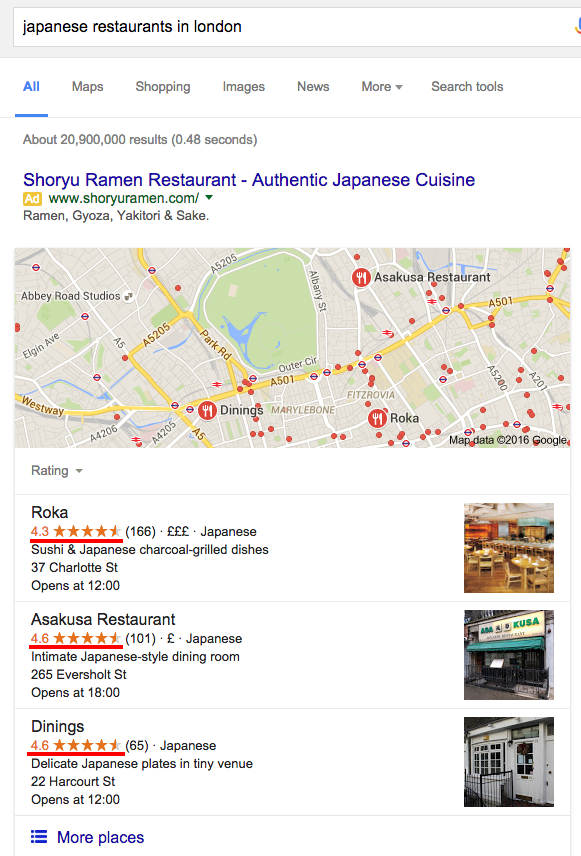Earlier this year, we published an in-depth guide to local SEO in 2016. Our recommendations for local SEO success in 2016 were built around three tactics:
- Ensure your business has a consistent name, address and phone number across all of the major directories and local listing websites
- Encourage your customers to review your business on websites like Yelp, TripAdvisor and industry-specific review platforms
- Use traditional off-page link building to improve your organic rankings for keywords that don’t have a pack of local results
Today, we’re going to look at the second of these three local SEO pillars: reviews and citations.
Reviews and citations are to local SEO what links are to traditional SEO. If your business has more reviews and higher ratings than its competitors, it’s more likely to appear in the “pack” of local listings that Google displays for geo-specific search queries.
This isn’t just speculation — it’s a clear fact. In our local SEO guide, we searched for a variety of geo-specific search terms and found that the highest rated, most reviewed listing had the most local SEO visibility for almost every search keyword.
More reviews and higher ratings means higher rankings, more traffic and more leads. It also means a higher conversion rate, since research shows that 90% of customers say a positive online review is likely to influence their decision to buy something.
For many businesses, getting these reviews and ratings is a serious challenge. As a result, many resort to using fake or “incentivised” reviews to improve their local search visibility.
In 2013, Google warned a number of SEO companies and businesses that were caught posting fake reviews. The same year, the New York attorney general fined businesses that bought fake reviews for local SEO. Some businesses were fined as much as $100,000 for faking reviews.
From penalties from Google to costly settlements, the consequences of faking reviews for your business are serious. Luckily, it’s usually not as difficult as you think to get positive reviews from your existing clients that have a measurable positive effect on your rankings.
Below, we’ve put together three tactics that you can use to encourage your customers to review your business on websites like Google+, Yelp and TripAdvisor. If you’re a local business owner that wants to rank higher and generate more sales from SEO, try using them to build your own scalable, effective review process.
Just ask
The first technique is a simple, obvious one that many businesses never try. If you’re struggling to get your first few positive reviews, just ask. When a customer or client has an experience with your business that’s obviously positive, ask them if they’re interested in writing a review.
Not all websites allow you to ask your customers for reviews, but the few that do are big enough that a specific focus on them can yield great results.
TripAdvisor allows you to ask your customers for reviews. In fact, it encourages businesses to ask their guests and customers to leave reviews, as long as they’re not incentivised.
This means that you can ask for reviews from your customers, as long as they don’t benefit from the review in any way. Free giveaways and payments are a no-no, but providing great service to a customer and subsequently asking for a review is directly encouraged.
Google’s policy is the same: businesses are encouraged to remind customers to leave reviews with their opinions. Paid reviews are banned (and obvious paid reviews could lead to a penalty) but free, non-incentivised reviews are welcomed.
Local SEO software company Whitespark has a great print-out template for asking customers to leave a Google review. After you’ve sold a product or provided a service, hand a review print-out to each of your customers — over time, many will follow up and review your business.
For websites like TripAdvisor, which aren’t included in Whitespark’s template, all it takes is a tiny modification to the template with appropriate instructions. We’ve included information on how to leave local SEO reviews in our full guide to local SEO in 2016.
Use customer feedback software
Software like GetFiveStars lets you simplify the process of earning local reviews by integrating it into your internal customer feedback survey.
Instead of being asked specifically to give feedback on third party review websites, GetFiveStars lets you email your customer list asking them to review your business for internal use. You’ll get a detailed summary of your Net Promoter Score and other important retention metrics.
After users leave feedback, they’re divided into several groups based on their experience with your business. Customers that had a positive experience and gave you a high ranking can be encouraged to leave reviews on websites like TripAdvisor, Google+ and Yelp.
Automating the review process through software like GetFiveStars has several advantages. It simplifies things massively for your business, since there’s no need to print and hand out any printed review forms when you can use your existing email list.
It also attracts a certain type of customer to review your business: a happy customer. You can choose to only show a call to action encouraging customers to leave reviews if they gave your business a positive ranking, for example, weeding out potential negative reviews.
If you already have an email list of customers, this strategy is a great way to earn two things at the same time: your business’s Net Promoter Score, as well as valuable reviews that drive your local search rankings.
Tap into your social media audience
If your business has a social media presence, it could be a valuable asset for earning positive reviews on websites like Google+ and TripAdvisor.
Social media audiences tend to be made up of people that already like your business, since it’s extremely unlikely an unhappy customer or client will like your Facebook page or opt to follow your Twitter account.
If you have several hundred or thousand followers on Facebook or Twitter, reach out to them to ask for feedback. For websites like Google+ and TripAdvisor, you can directly ask. For Yelp, it’s important not to directly ask for feedback — instead, just let users know that your page exists.
A simple message every month or two is often all it takes to bring your TripAdvisor or Google+ page to your audience’s attention, earning you a positive review or two in the process. Since you’re marketing to a warm audience, you’ll attract predominantly positive feedback.
You can also use this approach to earn more reviews on Facebook. Facebook reviews play an important role in establishing your business as a trusted authority, so don’t be afraid to ask your audience to review you on Facebook as well as Google+ and TripAdvisor.
Build your own local SEO review process
Getting new reviews for your business is like getting customers: the first few are hard, but once you’ve built a foundation, they’ll start to come naturally.
Use the three techniques above to build a foundation of reviews on Google+, TripAdvisor, Yelp and other local review websites that strengthen your website’s local search visibility, drive new customers to your website and fuel your local business’s growth.
Six months to one year later, these tactics can help you reach the top of the pack for your local search keywords and get a steady, consistent stream of new leads and customers.


 (
( (
(
 Like us on Facebook
Like us on Facebook
 Follow us on Twitter
Follow us on Twitter
 Connect on LinkedIn
Connect on LinkedIn